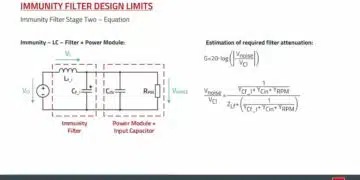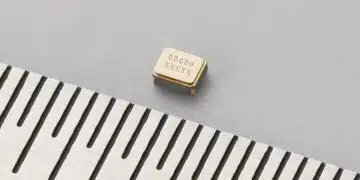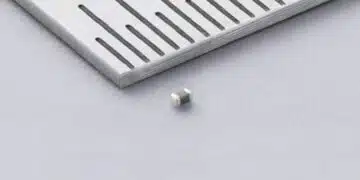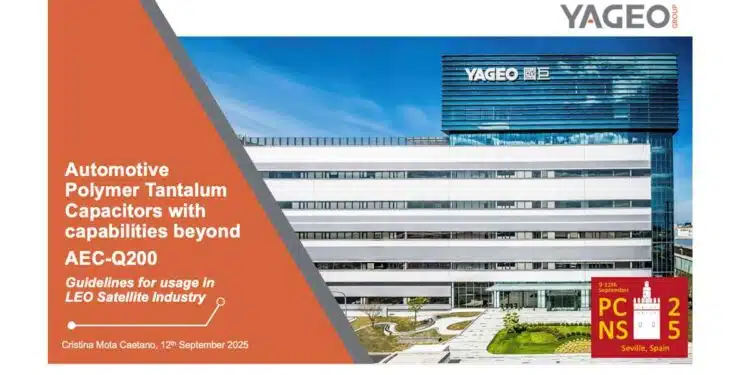The paper “Automotive Polymer Tantalum Capacitors with Capabilities Beyond AEC-Q200 –Guidelines for Usage in the LEO Satellite Industry” was presented by Cristina MotaCaetano, KEMET Electronics Portugal, SA, Évora, Portugal at the 5th PCNS Passive Components Networking Symposium 9-12th September 2025, Seville, Spain as paper No. 5.2.
Introduction
This article presents an in-depth exploration of automotive polymer tantalum capacitors and their potential applications in the Low Earth Orbit (LEO) satellite industry.
As the demand for small satellite constellations grows to support global broadband coverage, the need for highly reliable, lightweight, and thermally efficient capacitors has intensified. This document discusses how automotive-grade polymer tantalum capacitors can exceed traditional AEC-Q200 requirements and provide robust performance under the unique challenges of space environments.
Key Points
- LEO satellite constellations will continue to expand rapidly, driven by the demand for high-speed, low-cost broadband services.
- Tantalum polymer capacitors offer advantages such as low ESR, compact size, self-healing properties, and superior frequency response.
- Automotive polymer tantalum capacitors (T59x/T598 series) demonstrate capabilities beyond AEC-Q200, including extended endurance life, radiation tolerance, low outgassing, and compliance with space derating guidelines.
- Adoption in space applications is supported through up-screened options, Sn-Pb terminations to mitigate tin whiskers, and robust testing (screening, LAT, DPA, radiation, and environmental tests).
- Best practices include 50% voltage derating in extremely dry and cold space conditions to minimize anomalous charging current (ACC).
Extended Summary
The global small satellite market is projected to reach $11.2 billion by 2029, with a CAGR of 16.6%, fueled by demands from commercial, governmental, and rural broadband sectors. Designing small satellites imposes strict constraints on size and weight, which drives the selection of high volumetric efficiency components such as surface-mount polymer tantalum capacitors. Compared to legacy MnO2-based devices, polymer tantalum capacitors exhibit lower ESR, better power efficiency, smaller thermal footprint, and enhanced high-frequency performance.
Automotive-grade polymer tantalum capacitors, like the Kemet YAGEO T59x and T598 series, are designed for demanding environments up to 150°C. They are available in a wide range of case sizes, voltage ratings up to 75V, capacitances up to 680 µF, and ESR as low as 6 mΩ. To meet space application needs, these capacitors undergo up-screening processes aligned with MIL-PRF-55365 or MIL-PRF-32700, including extended surge testing at varied temperatures. The addition of Sn-Pb termination (H option) addresses the risk of tin whiskers in vacuum environments.
Destructive Physical Analysis (DPA) and visual examinations confirm mechanical and constructional integrity, with no defects or unacceptable delamination in the capacitor layers. Extended endurance life testing demonstrates the T598 series maintaining stable ESR, capacitance, and leakage current over 10,000 hours at 125°C and 0.67 rated voltage, doubling typical AEC-Q200 requirements. Accelerated storage and aging studies project reliable long-term operation for automotive and LEO satellite mission profiles.
Radiation testing using Cobalt-60 gamma irradiation up to 212 krad (Si) confirms that polymer tantalum capacitors are inherently radiation hard, with stable capacitance during irradiation and subsequent annealing. Outgassing tests per ASTM E595 show exceptionally low Total Mass Loss (TML) and Collected Volatile Condensable Materials (CVCM), validating their suitability for vacuum and high-altitude environments.
A notable phenomenon in space applications is anomalous charging current (ACC) under step voltage application in dry, cold conditions. While it poses no risk to the capacitors themselves, it can affect system behavior. A 50% derating strategy is recommended to mitigate this effect and ensure optimal reliability.
Conclusion
Automotive polymer tantalum capacitors, particularly the T59x and T598 series, offer exceptional performance beyond standard automotive qualifications and are well-suited for use in small LEO satellite constellations. Their low ESR, radiation tolerance, robust long-term endurance, and compliance with space-specific testing and derating practices make them a competitive choice for next-generation space applications. By combining automotive-grade manufacturing maturity with specialized up-screening, these capacitors open new opportunities in the rapidly expanding small satellite market.





























